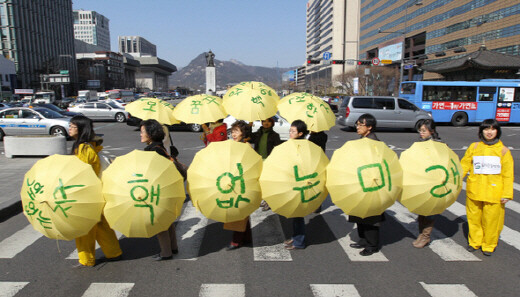hankyoreh
Links to other country sites 다른 나라 사이트 링크
Civic groups call for closure of aging nuclear plant

By Park Ju-hee
As the crisis at Japan’s Fukushima Dai-ichi nuclear power plant races out of control following a series of explosions resulting from last week’s earthquake and tsunami, concerns are mounting rapidly among South Koreans living near power plants. Civic organizations in the area of Gyeongju, North Gyeongsang Province, demanded the permanent closure of the No. 1 reactor of the Wolseong Nuclear Power Plant in the city’s Yangnam Township. The extension of the reactor’s operating life is under examination.
Hoisting a banner reading “Wolsung = next Hukusima,” members of Gyeongju Nuclear Safety Solidarity held a press conference Thursday in front of Gyeongju City Hall, where they demanded that authorities “withdraw plans to extend the operational life of the decrepit first reactor at the Wolseong Nuclear Power Plant, and close it permanently.”
The group was organized by twenty local civic and social organizations including the Gyeongju Federation for Environmental Movement.
“The series of explosions at the Fukushima plant shows that the more time-worn a power plant is, the more it is susceptible to natural disasters such as earthquakes,” the group said. “As citizens of a city with numerous nuclear power plants, we cannot view the Japanese people’s tragedy as someone else’s affair.”
The No. 1 reactor at Wolseong, which began commercial operation in April 1983, is facing the end of its thirty-year design lifespan in March 2013. The Ministry of Education, Science and Technology (MEST) is scheduled to make a decision around June as to whether to prolong its lifespan by another ten years.
“The Eupcheon Fault near the Wolseong plant is an active fault, so there is a possibility that the land may be unstable as a result of the earthquake in Japan,” the group said.
The Wolseong Nuclear Facility Environment and Safety Monitoring Committee (WSNESC) produced an analysis of tritium concentrations in the bodies of residents in the area around the Wolseong plant. According to the group, the concentration of tritium in the bodies of residents of Naa Village in Gyeongju’s Yangnam Township, at an average of 23.6 becquerels per liter, is 25.7 times higher than the 0.919Bq/L concentration seen in residents of Gyeongju’s urban area.
Please direct questions or comments to [englishhani@hani.co.kr]
Editorial・opinion
![[Guest essay] Preventing Korean Peninsula from becoming front line of new cold war [Guest essay] Preventing Korean Peninsula from becoming front line of new cold war](https://flexible.img.hani.co.kr/flexible/normal/500/300/imgdb/original/2024/0507/7217150679227807.jpg) [Guest essay] Preventing Korean Peninsula from becoming front line of new cold war
[Guest essay] Preventing Korean Peninsula from becoming front line of new cold war![[Column] The state is back — but is it in business? [Column] The state is back — but is it in business?](https://flexible.img.hani.co.kr/flexible/normal/500/300/imgdb/original/2024/0506/8217149564092725.jpg) [Column] The state is back — but is it in business?
[Column] The state is back — but is it in business?- [Column] Life on our Trisolaris
- [Editorial] Penalties for airing allegations against Korea’s first lady endanger free press
- [Editorial] Yoon must halt procurement of SM-3 interceptor missiles
- [Guest essay] Maybe Korea’s rapid population decline is an opportunity, not a crisis
- [Column] Can Yoon steer diplomacy with Russia, China back on track?
- [Column] Season 2 of special prosecutor probe may be coming to Korea soon
- [Column] Park Geun-hye déjà vu in Yoon Suk-yeol
- [Editorial] New weight of N. Korea’s nuclear threats makes dialogue all the more urgent
Most viewed articles
- 1Yoon’s broken-compass diplomacy is steering Korea into serving US, Japanese interests
- 2[Guest essay] Preventing Korean Peninsula from becoming front line of new cold war
- 3South Korean ambassador attends Putin’s inauguration as US and others boycott
- 4Behind-the-times gender change regulations leave trans Koreans in the lurch
- 5Family that exposed military cover-up of loved one’s death reflect on Marine’s death
- 6Yoon’s revival of civil affairs senior secretary criticized as shield against judicial scrutiny
- 7Japan says its directives were aimed at increasing Line’s security, not pushing Naver buyout
- 8Marines who survived flood that killed colleague urge president to OK special counsel probe
- 9Amid US-China clash, Korea must remember its failures in the 19th century, advises scholar
- 10‘Weddingflation’ breaks the bank for Korean couples-to-be